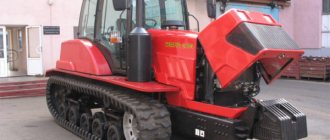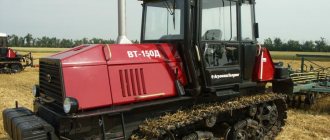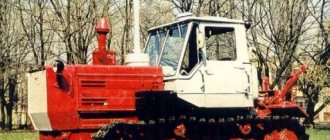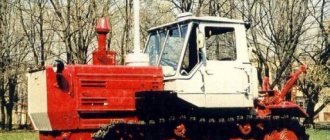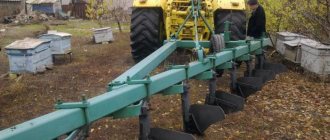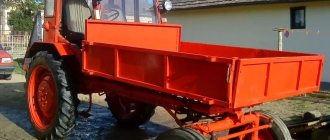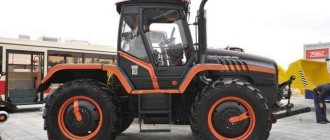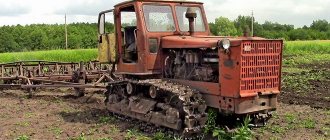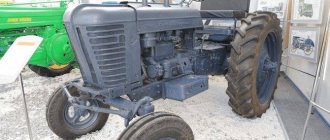Crawler tractors are not particularly popular, since the functionality of this equipment is significantly limited. But, despite this, some of the models still find application. These include the T-70. The tractor was released in 1974, had several modifications and was intended to perform a fairly wide range of agricultural and horticultural work. Currently, this equipment has been discontinued.
Modifications
In total, several modifications of this model were produced. The T-70S tractor was the first to be designed, intended for beet harvesting. Later, production of the T-70A and T-70SM began. This technique was used in horticultural farms. The T-70V tractor was designed for work in vineyards. Model T-70V-X - for performing work in fields sown with hops. However, the main difference between the models was only in the width of the tracks.
The lineup
Among the modifications of the T-70 produced by the Chisinau Tractor Assembly Plant are the following:
- T-70S - for processing sugar beets (year of production 1974);
- T-70V - for cultivating vineyards;
- T-70 SM - improved cabin, moving the hydraulic distributor to the rear wall of the cabin;
- T-70ВХ - tractor for processing hop crops (modified hydraulic system).
All modifications of the T-70 had only minor differences, since they were technically the same with the only nuance that they were used to work with certain crops. Feedback from farmers about this model is mostly positive. Thanks to its narrowly targeted use in agriculture, the T-70 tractor has become an ideal machine for working with soil and for growing various crops.
Features of application
T-70 is a tractor that was originally designed to perform various agricultural work using additional semi-mounted and mounted equipment. Despite its relatively small size, it was possible to install more than 50 types of agricultural units and machines on it, which did not exceed the lifting capabilities of the tractor itself.
This technique was perfect for a variety of jobs in beet fields, but was most often used for other crops as well.
Ease of use, especially when inter-row processing of crops, was ensured by the relatively small track track, due to which there were minimal losses of crops during the work.
For general purpose work, the T-70 tractor was equipped with tracks 300 mm wide, but for inter-row processing the tracks were changed to narrower ones, 200 mm wide.
The functionality of this technology was not limited to agricultural activities alone. The T-70 could also be used for road and construction work that does not require much power. Due to its compact size, one of its representatives was included in the technical composition of the Arctic expedition that took place in 1978.
The front suspension must be adjusted so that when the tractor is parked on a level surface, the horizontal axis of pipe 36 (see Fig. 35) is located 5-10 mm above the axis of pin 10 connecting lever 17 to the connecting rod. This is achieved by twisting the torsion bars. The adjustment procedure is as follows.
Jack up the tractor from the front so that access to levers 17 is provided; unscrew bolts 18 and remove wedge 19
take out plugs 11 and knock out pin 10.
Lever 17 of one side is installed in a horizontal plane, and the opposite side is turned one spline down until the splines in the pipe and on the torsion bar coincide. Adjust the axial clearance and secure the levers.
During assembly, carefully place the connecting rod seals in place, lubricate the friction surfaces and fill the resulting cavity with lubricant.
To properly adjust the rear suspension, the tracks must be disconnected. Place the tractor frame on the front support, jack up the rear frame until the rear support rollers come off the tracks, and then remove the splined bushings 6 and spacers 8.
Set a gap equal to 45-47 mm between the cylindrical part of the lever 37 and the bolt 22. Put the splined bushing 6 in place. The gap between the side surfaces of the bushing ear and the groove of the lever 37 is in the upper half on the side of its body, and in the lower half on the side of its body. the heads are filled with adjusting shims 24. The shims are L-shaped, with holes made on one side. The side of the gasket with the hole is placed in the gap between the bushing ear and the end of the lever groove. Tighten the outer bolts.
Adjust the axial movement of the levers relative to pipe 41 and tighten the central bolt 38. Lower the tractor to the ground, start the engine and drive a few meters. Stop the engine, tighten and lock the outer bolts, and the gap between bolt 22 and lever 37 should be 15-17 mm.
If the gap value deviates from these values, additional adjustment is made: bolt 22 is screwed in or out. As a result, it must be securely locked with nut 23 and protrude above the platform by no more than 38 ± 5 mm. It should be remembered that the bolt serves only for additional adjustment of the gap; its use for basic adjustment is not allowed!
If the gap is more than 17 mm, it can lead to breakage of the torsion bars, and if the gap is less than 15 mm, the drive wheel will come into contact with the ground, which will cause vibration of the frame. When vibration occurs, a “breakdown” of the suspension is observed; vibration is felt especially strongly when driving with an agricultural implement in the transport position.
On tractors produced before 1977, there was no adjusting bolt 22, and adjustment was carried out so that the gap was 40-44 mm. This led to the fact that when lowering the tractor onto the ground, the gap became equal to 12-17 mm.
On tractors manufactured since 1977, adjustment of the axial clearance of levers 17 relative to the front suspension pipe and levers 37 relative to the rear suspension pipe is simplified. Gaskets 8 are removed and adjustment is performed by tightening one of the bolts 25 and all bolts 38 until they stop. After this, the bolts are unscrewed 3/6 of a turn and locked. In addition, the rear suspension of the tractor allows you to adjust the track so that it coincides along the drive wheel and the rear road wheel. The permissible difference in measurements from the roller flanges (internal and external) to the end of the drive wheel crown should not exceed 10 mm. To perform this adjustment, shims 24 are used. They can be used to adjust the tractor track along the rear roller within ±5 mm. With an increase in the number of spacers under the eye of the spline bushing 6 and the end of the groove of the lever 37, the track decreases, and vice versa. The maximum permissible thickness of the gasket package is 5 mm.
content .. 13 14 15 16 ..
Main advantages
This technique was appreciated by machine operators and agronomists of the Soviet Union; it was small in size, could perform work on steep slopes, and was distinguished by cross-country ability and maneuverability.
Access to the main components did not cause problems, making the repair and maintenance of these machines convenient.
The design features of the chassis made it possible to use the T-70 tracked tractor for work on black soil. Since this soil has a rather fragile structure, wheeled vehicles caused irreparable damage to it.
An important advantage is fuel savings of up to 20% compared to wheeled models of the same class.
History of appearance
The T-70 tractor is the development of engineers from the Kishinev Tractor Assembly Plant. The plant was created in 1961, and already in 1974 mass production of the T-70 model began. During the creation of the technical base of the plant in Chisinau, all the forces of the leading machine-building enterprises of the USSR were thrown at the facility, in particular, KhTZ (Kharkov), MTZ (Minsk) and the Altai Plant (ATZ). The model is a second traction class vehicle.
The predecessors of the T-70 tracked tractor model were such tractors as the T-50V, T-54V. The appearance and design were similar to the MTZ-80 tractor. Despite the efforts of Chisinau specialists, the T-70 did not receive such widespread popularity as the Belarus tractor.
Flaws
The main disadvantage of a crawler tractor is its low weight. When plowing on hard ground, he cannot move the plow. Therefore, we can also highlight the imperfect design of the lugs.
The narrow base of this machine, for which all agronomists valued it, also played a negative role. Due to the almost complete lack of balancing, the tractor fell on its side on large inclines.
In addition, due to the fact that the production line was located on the territory of Moldova, problems arose with spare parts.
Positive and negative qualities of the car
The T-70 is endowed with a whole range of advantages, including:
- Impressive traction power.
- Excellent maneuverability.
- Safe and trouble-free work on slopes.
- Economical operation.
- Great functionality potential.
In addition, wheeled tractors often put very strong pressure on the underlying surface, thereby causing its degradation. But the T-70 tracks do not have this drawback; they act on the ground gently and carefully, which ensures the preservation of all the beneficial properties of the soil.
An important nuance: the T-70 moves its weight with an effort that is half that required for a wheeled model. In this regard, daily fuel savings will be about 19%.
The disadvantages of the car include the complexity of repairs in the event of a breakdown and limited movement on hard surfaces, in which the driver will feel any unevenness on the road, and even a seat with springs cannot solve this issue.
Description of technical characteristics
The T-70 tractor has the following technical characteristics.
This is a relatively compact equipment with overall dimensions of 3330x2970x1650 mm. The wheelbase is 1895 mm, the track size is 1350 mm, and the ground clearance is 460 mm. The weight of the tractor is 4000 kg, but the specific pressure on the soil, due to the tracked undercarriage, is 0.7 kgf/cm2. Transport speeds are far from ideal. Thus, its maximum forward speed is 11.35 km/h, and its maximum reverse speed is 4.86 km/h. At the same time, the traction force (nominal) is 2 tons.
The main operational indicators, size and weight of the T-70 tractor are indicated in the table:
| Parameter | Index |
| Length | 3300 mm |
| Tractor height | 2970 mm |
| Width T-70 | 1650 mm |
| Structural total weight | 4000 kg |
| The track is | 1350 mm |
| Ground clearance (clearance) | 460 mm |
| Ground pressure indicator | 0.7 kgf/cm2 |
| Nominal pulling force | 2000 kgf |
| Speed | 11.3 km/h |
Unpretentiousness and simplicity of design are the main advantages
Suspension elements of specialized equipment of this type consist of a rear, front pipe and articulated arms, to which elastic components (torsion bars) are connected. Torsion bars have a round design and are located in the inner part of the pipes. To increase the productivity and quality of the tractor's performance of direct functional tasks, the T-70 uses track chains with a link width of no more than 200 millimeters. Split type bushings pressed into the chain are easy to replace when worn. To carry out work operations not related to harvesting (processing) crop fields, that is, for general work, the use of three hundred millimeter track chains is provided. An individual feature of this tractor model is the presence of a rear PTO, which is equipped with independent, synchronous drives.
Important What you need to know about repairing the main working parts of forklifts
The T 70 tractor weighs no more than four tons. In this case, the maximum level of traction force is about two tons. The machine can operate in eight alternately switchable speed modes when moving forward, and two-speed reverse modes. The operational speed capabilities of the vehicle are in the numerical range of 1,356-11,358 kilometers per hour when the vehicle is moving forward, and 2,855-4.86 when the vehicle is moving backward. The maximum power level of the diesel engine installed on this equipment is up to 75 liters of pumping fuel mass in one second. Specific fuel consumption is no more than 190 g/e. l. With. h. The working tank for storing fuel resources has a volumetric capacity of up to 160 liters of liquid mass.
All of the above technical properties of this tractor model, combined with the availability of purchasing the T-70, the price of the tractor will be no more than 120 thousand rubles, for a machine with a designated operational mileage, but has undergone major repairs and is in excellent working condition, determine the wide popularity of such a transport facilities. The comparative efficiency of the equipment and the high productivity level put the tractor at the forefront of special equipment, which is used in various spheres of human activity.
Chassis
When creating the T-70 tractor, the wheeled MTZ-80 was taken as a basis, from which many components were borrowed. The load-bearing basis was the spar half-frame. The spars at the front were connected to each other by a transverse metal beam, which served as a kind of stiffening rib. At the rear, the spars were connected to each other by a rear axle. The suspension was provided by round transverse torsion bars, which were installed two at a time at the front and at the rear.
The rear axle included a main bevel gear, two gearboxes, which are made in separate housings and installed on the sides of the axle, a turning mechanism, a power take-off shaft and a brake band mechanism.
The rotating mechanism was made in the form of friction multi-disc clutches. The floating brake band mechanism made it possible to brake when moving both backwards and forwards. Each side was equipped with its own braking mechanism.
Using two levers from the cockpit, the rotating mechanisms were controlled. The brake mechanisms were controlled using two pedals. Hydraulic boosters eased the force on the brake pedals and swing arms.
The chassis of the T-70 tractor consisted of rear drive sprockets, front idler wheels, rollers, tracked bogies with support rollers, supporting tracks, and, in fact, the tracks themselves. The caterpillar track for the T-70 tractor consists of tracks and connecting pins.
Two types of power take-off shaft drive (independent and synchronous) made it possible to provide 2 shaft rotation speeds.
Coupling with semi-trailer and trailed units and mechanisms was carried out using rear mounted equipment equipped with an automatic coupler. And to perform work with hydraulically powered machines, the tractor had a separate hydraulic system.
The cabin on this tractor was metal, dimensional, closed, with a large glass area, designed for two people.
Attachments
The T-70 tractor is equipped with 2 PTO drives:
- independent or geared, which gives 2 rotation speeds - 540 and 1 tf. rpm;
- synchronous – for every meter of travel it creates 5.34 revolutions.
The functioning of attachments is guaranteed by a hydraulic system - hydraulic pump, hydraulic distributor, cylinders, consumables.
Due to PTOs and hydraulics, the T-70 tractor is compatible with:
- plows;
- hillers;
- cultivator cutter;
- potato digger and planter;
- harrow;
- seeder;
- rakes and pitchforks;
- mowers;
- sprayers;
- fertilizer diffusers.
Trailers and carts are connected to the T-70 tractor via a three-point hitch.
Operation of the unit with a front blade shovel, front loader (kun), bulldozer and skidding attachments is possible only after serious alterations (as in the video).
Engine
T-70 is a tractor that was equipped with a diesel 4-stroke four-cylinder D-240 engine with a power of 78 horsepower. Fuel consumption per hour - 190 g/l. The volume of the fuel tank was 160 liters.
A distinctive feature of the engine was direct fuel injection and a liquid cooling circuit. The base model of this series was equipped with an additional gasoline engine. It was with its help that the main diesel engine was started. Later, Moldovan engineers abandoned this complex launch system. In modifications it was significantly simplified through the use of a practical electric starter.
The presence of a cold start system made it possible to work in the cold season. According to reviews from owners and tractor drivers, the T-70 tractor is very undemanding when it comes to the quality of fuels and lubricants.
Transmission
Almost all tractors produced by the Chisinau Tractor Plant had a mechanical transmission. The T-70 was no exception. The gearbox provided 8 forward and two reverse speeds. Under the gearbox cover was a set of permanently meshed gears.
A dry-type friction single-plate clutch connected the transmission unit to the engine.
The gearbox is connected using a gear coupling. Additionally, hydraulic reinforcement was installed, which significantly simplified control. Due to splined clutches with synchronizer, gear shifting was shockless. The main advantage of this gearbox was that stopping the special vehicle was not required to change gears.
Steering T-70
The turning radius of the T-70 crawler tractor is determined by multi-disc clutches installed on the splined connection of the rear axle. A band-type floating brake system complements the rotary mechanism.
The steering consists of two levers, as well as a hydraulic booster. Such a system has some difficulties. It is necessary to constantly monitor the condition of clutches and brakes.
The rotating mechanism mainly consists of rubbing parts, as a result of which it is subject to rapid wear. If there is play in the control levers, the clutches may be completely disconnected, and in this case it will be impossible to control the vehicle.
Features of the hydraulic system
T-70 is a tractor with a complex hydraulic system consisting of two oil lines: low and high pressure. They are connected to each other using flexible hoses and supplemented with an oil container. The hydraulic fluid is distributed between the units by a pumping station, pneumatic distributors and cylinders.
The hydraulics work according to the following scheme. The pump pulls oil from the tank and pushes it to the distributor. In turn, the distributor redirects this fluid to the desired cylinder, as a result of which the attachment is raised and lowered. After the need for additional equipment disappears, the liquid flows back into the tank.
Attachment system
To install attachments, a classic three-point tractor mounting scheme is used.
Interesting! The automatic coupler is designed for more than fifty different types of equipment. Mechanized attachments can be connected
- to the hydraulic system;
- to the power take-off shaft.
Onboard hydraulics are technically built according to a block diagram. Its individual units are a pump, a distributor, a supply tank, pipelines and power cylinders.
The power take-off shaft is driven by the engine using a two-speed gearbox.
Some owners independently modify the design by installing a front unit for attachments (for example, a bulldozer blade).
A separate hitch is provided for trailed units.
Tractor T-70: repair
Installation of the D-240 engine provided this tractor model with good maintainability. If all operating rules and standards were observed, significant engine breakdowns occurred quite rarely. The gearbox also did not cause any particular trouble.
The problems were mainly caused by the chassis. We had to monitor the condition of the drive sprockets and road wheels. In addition, constant monitoring of track tension was required, especially when the T-70 was equipped with narrow tracks. Even with a little loosening, they fell off easily.
But, despite certain problematic components, this equipment from the Chisinau designers turned out to be quite successful, since the T-70 tractor has quite positive reviews from owners of both the Soviet era and its contemporaries. They noted ease of use, efficiency and reliability. These machines continue to be used in gardening and field work.
Still, the tractor failed to achieve significant popularity.
It is not at all difficult to buy spare parts for the T-70 tractor. Most of them come from the MTZ 80 model. Since the Tracom association, which became the successor to the Chisinau Tractor Plant, produces spare parts, you can even purchase new chassis components.
